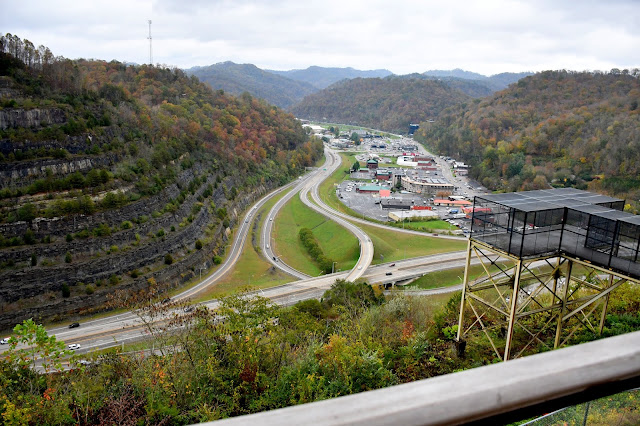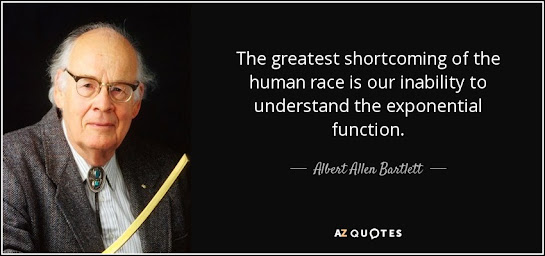What is NTHE and How "near" is Near Term?
I distinctly remember my first introduction to the initialism (or abbreviation or acronym) "NTHE" which ushered me into a whole new set of exploration. I was a member of a climate change group on Facebook at the time (which I had been a member of for quite some time) and I saw a post which was discussing it. I hadn't seen this abbreviation before and wondered what it meant, so I did a search and a whole list of links was presented (as usual) along with the spelled out version, Near Term Human Extinction. I clicked on one which took me to a website blog by Dave Pollard. I started reading and was introduced to another person, Carolyn Baker, with whom Dave had a video interview with. Through this video, I was introduced to another person, a professor by the name of Guy McPherson. A video of him presenting information at an Indiana university, DePauw, where my grandmother attended, was available; so I watched it. The information was stark and I noticed the looks on the kids' faces as he went through the presentation. I was skeptical at first, as I almost always am when presented with information which is new or different from what I expect or know to be true.
I went through the same stages of grief that many people do, starting with denial. The first thing I did was look for evidence that human extinction was not possible. There were many articles coming out against Guy's claims, but no scientific papers or credible writings actually confirmed that extinction was not possible. After reading the articles against Guy's claims, I realized that the reasonings that were used had little to do with any actual evidence against the science. This had more to do with personal FEELINGS associated with not liking the evidence presented - simply put, these folks were suffering from denial of reality. I think that way too many people engage in attempting to discover a timeline, and perhaps THIS is why so many people don't consider the message accurate. Since I have seen so many different timelines and have read so many different scientific studies, I realize that attempting to discover a timeline is much too difficult due to so many possible variables which are constantly changing. However, the general trajectory and the science behind his warnings are true and accurate. I do not personally subscribe to the idea of the entirety of humanity being extinct within the next decade or two, but I cannot prove or disprove such a claim either. The likelihood that humans will occupy this planet by 2100 is fairly remote at best. Most of the planet's wild inhabitants will be gone by 2050 due to a cascading failure of agriculture, biodiversity loss, pollution loading, and energy and resource decline (along with ecological collapse, which is already occurring now in the mass extinction that we are driving). The wild inhabitants are the organisms which support our existence through the ecosystem services they provide; so once they are gone, we are soon to follow. One recent study indicates that we are probably underestimating species' vulnerability to extinction, quote:
"The way we currently estimate climate change vulnerability may be underestimating extinction vulnerability," Dr. van Heerwaarden said.
"We need to consider fertility if we want to understand the impacts of climate change on biodiversity," she said.
"Species that we thought could tolerate 7 °C of warming may already be experiencing temperatures that are within 1 °C of their male upper reproductive limit. If males are unable to fertilize females, populations will crash and be unable to replace themselves."
Current trajectories are such that humans may disappear due to infertility due to pollution loading, and the constant bargaining (versus acceptance) being done with regard to technology use guarantees more and broader pollution loading to come. What it DOESN'T guarantee is a solution to any of the predicaments we suffer from. [Additional paper here]
UPDATE September 2023: The above paragraph includes an article from Shanna Swan, but a new article from Richard Heinberg demonstrates more recent studies and figures outlining how not only will humans experience fertility issues, but ALL animal species are suffering the same effects.
UPDATE October 2024: Two new books and a video provide much additional information as to why extinction is more or less guaranteed. The first book is by biologist Nicholas Money. The second book is by Lyle Lewis. Check out this video with Sandra Schoelles interviewing Lyle.
This particular post from Dr. B. Sidney Smith may be helpful in comprehending the situation. He also has provided this presentation.
Update July 2021: Here is yet another presentation demonstrating just how quickly civilization has converted millions of years of sunlight and photosynthesis into carbon dioxide and other greenhouse gases, this one from Professor Will Steffen.
This article from Henry Gee, a paleontologist, evolutionary biologist, and editor at Nature, writes that humans are doomed to go extinct due to habitat degradation, low genetic variation, and declining fertility, quote:
"The most insidious threat to humankind is something called “extinction debt.” There comes a time in the progress of any species, even ones that seem to be thriving, when extinction will be inevitable, no matter what they might do to avert it. The cause of extinction is usually a delayed reaction to habitat loss. The species most at risk are those that dominate particular habitat patches at the expense of others, who tend to migrate elsewhere, and are therefore spread more thinly. Humans occupy more or less the whole planet, and with our sequestration of a large wedge of the productivity of this planetwide habitat patch, we are dominant within it. H. sapiens might therefore already be a dead species walking.
The signs are already there for those willing to see them. When the habitat becomes degraded such that there are fewer resources to go around; when fertility starts to decline; when the birth rate sinks below the death rate; and when genetic resources are limited—the only way is down. The question is “How fast?” "
Update 8-2-22: A new study lays out a stark reality in a new article, quote:
"The world needs to prepare for human extinction because of climate change, according to a shocking new study.
Scientists say global warming could become “catastrophic” for humanity if temperatures rise by even more than they are predicted to, or if heating sets off chains of events that have not yet been predicted.
A team led by Cambridge University academics in the UK say we should prepare for horror scenarios ranging from the loss of 10 percent of the world’s population to the end of human life on Earth."
Update December, 2022: A new study shows extinction cascades will wipe out more than 25% of world biodiversity, quote:
"A new tool developed by European and Australian scientists enabling unparalleled modeling of interconnected species loss shows cascading extinctions are unavoidable, and that the Earth will lose some 10% of its animals and plants by 2050, rising to 27% by 2100."
Four other posts I wrote deal with specific angles of ecological overshoot and make clear that the scope of predicaments is rather large indeed. After writing this and realizing that this post is one of the more popular, I decided to add these additional posts here to point out these realities. The first one deals with attempting to ramp up nuclear power to deal with the inevitable loss of fossil fuels and why actually using it to replace fossil fuels is entirely unrealistic due to energy and resource decline. The second one deals with relocating due to sea level rise (SLR) and points out the myriad of issues SLR will present as time moves forward. The third post which brings healthcare and medications into the mix points out how much the industry depends upon the fossil fuel platform (and transportation grid) and the electrical grid and how this will be affected due to energy and resource decline. The last article explains how difficult it would be for humanity to experience radical transformation in a timeframe suitable to avoid absolute disaster and precisely why this is not only unlikely but that even if we WERE to readjust cultural and societal systems how doing so STILL won't solve the fact that civilization is inherently unsustainable. This short (less than 20 minutes) video highlights precisely why and how industrial civilization is self-terminating. Once one understands these issues, one can more quickly ascertain why extinction is inevitable and why it will be happening much faster than some people think. One additional study and the associated article will help foster more understanding as to the evolution of all of this. That particular study goes into explaining a particularly pervasive predicament upon not only how we got to this point, but also why extinction is our destiny.
One recent study which provides a new framework for collapse and includes a whole host of other studies, some mentioned here and some in other articles of mine, introduces a causal loop diagram of the predicaments and is one of the more comprehensive studies available.
Last but not least, one other phenomenon which has nothing to do with ecological overshoot may complicate matters even if humans are able to perform a miracle and avoid extinction; a pole reversal.
Many people ask how near is "near term" so as to discover how long society will continue. I look at extinction as a process, a journey; rather than an event which happens at a certain time. Obviously, human extinction is a given. No species lasts forever, and like Carl Sagan said:
So this means that human extinction WILL happen sooner or later regardless of what one thinks or believes. However, many different variables now make clear that humans are on an increasingly quicker trajectory toward this end much faster than expected. One of the possible causes of human extinction will most likely involve the functioning of the ozone layer as is explained in this post regarding James G. Anderson and his findings. That post leads into this post regarding hydrogen sulfide. Many people appear to forget that we are a part of nature and that we are animals, not machines. We require habitat, and because we are large animals, our biological requirements are quite different than small mammals such as mice. Large animals tend to live longer and are therefore subject to far more issues such as disease. Disease often begins with exposure to certain chemicals, toxins, or other animals which harbor viruses or other microbial infections. The current coronavirus pandemic makes it clear just how precarious our existence really is. Nobody is guaranteed tomorrow.
There are other issues regarding large versus small animals; mice are likely to be more successful at surviving than humans in a rapid climate change scenario because 1) their food requirements are smaller; 2) they're more successful reproductively because they have a short gestation period, produce many offspring per birth and; 3) those offspring need minimal parental care and are sexually mature in a relatively short time. Humans, on the other hand, have a long gestation period, produce (usually) one offspring per birth, which needs extensive parental care before it can forage for itself, and takes 12 or so years to become sexually mature and breed. So in adverse, rapidly-changing conditions, mice can build up their populations quickly whereas humans can't. These are called r and K strategies. This would work against humans in rapidly-changing conditions, because they can't build up numbers quickly to avoid extinction, so this is another reason for (relatively) NTHE.
Because we depend upon habitat supplied by the ecosystem services other species provide for us, the loss of those species increasingly will affect our survival. This article demonstrates just how vulnerable we are, quote:
"However, male fertility at high temperatures—rather than the temperature at which they stopped moving or died—was the best predictor of the likelihood of warming extinction. Importantly, they showed that the temperature at which males could no longer reproduce was much lower than temperatures that killed them."
However, as I pointed out in the Denial of Reality post, many different biological realities exist which put our existence on an even smaller thread when taken into the context of having habitat available. Really, all one must do is take a look at the different predicaments contained within the files I have compiled on this blog to realize that as time moves forward, more and more issues develop which put us ever-closer to the Seneca cliff of ecological collapse which seals our fate. It is our ability to innovate (we are an innovating species) where innovation breeds innovation that brings exponential change to the forefront, which inevitably eventually leads to us being unable to adapt.
A very large and broad portion of world population WILL succumb to these predicaments over the next decade or two, all of them due to ecological overshoot, the parent predicament of all the predicaments that make up this blog. However, precisely how large this number will be is still in question. One can look at individual events caused by climate change around the world and see how larger and larger numbers of people are being affected by and/or killed by these events and/or the failure of infrastructure (which provides habitat) caused by said events. Still, these numbers are quite small in comparison to the numbers of people being born regularly. One website includes population figures as well as coronavirus figures, and a quick check shows that we are getting rather close to 7.9 billion people on this planet.
Needless to say, while I certainly don't think we'll all be gone anytime this decade, I also think that anyone who thinks we'll still be around by the end of the century is suffering from denial of reality and Optimism Bias.
Thanks to Bev Courtney for this idea!












It's a pleasure for me to read a measured critique of NTHE and I'm glad to see my co-host on Nature Bats Last on PRN.FM being treated with respect.
ReplyDeleteProfessor Guy McPherson has shouldered the greatest task with diligence and integrity. I'm proud to call the man my brother.
Guy's website is at GuyMcPherson.com